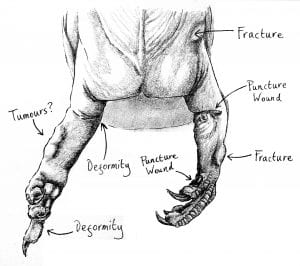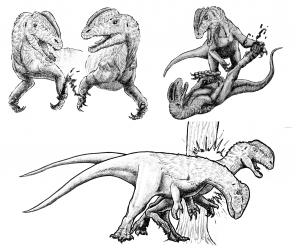Guest Author – James Ormiston
Palaeontology & Evolution MSci Graduate
Dilophosaurus: my favourite dinosaur and one of Jurassic Park’s only celebrity species to actually come from the Jurassic period. This is a dinosaur which, perhaps more so than any other to appear on screen, has suffered a persistent identity crisis thanks to some major creative liberties taken by Crichton and Spielberg to make it more intimidating (and it worked on me, as a child it was by far the one that scared me the most). But that part is already addressed in a previous article on the blog. Today we’re going to take a look at another intriguing aspect of Dilophosaurus which could tell us a lot about what it was like to walk in its…um…dino-shoes? Di-loafers-aurus? Maybe let’s leave the palaeo-puns in the ground…
Dilophosaurus seems to have a helpful habit of giving us interesting insights into its palaeobiology. It is the suspected owner of some remarkable fossil footprints at the St George Dinosaur Discovery Site in Utah. Not only was it (or a dinosaur very much like it) walking along, but also appears to have sat down for a while, had a little shimmy-along, and got up again. Its teeth are long and needle-like, and it has a notch in its upper jaw (rather like the later spinosaurids), which has led to some speculation that fish formed a part of its diet. In Jurassic Park it was given a neck frill, spat venom etc., which were alterations made for entertainment’s sake (see Rhys’ November 2019 article for a full breakdown), but the real thing was quite a bruiser in its own right. And by that I don’t just mean it was dealing out the bruising, but taking a fair bit itself. This shouldn’t really be a surprise, after all animals are injured and get in scraps for all sorts of reasons. But it still offers us a fascinating, intimate peek into the lives of dinosaurs. Join me as we take a dive into the prehistoric autopsy room and investigate a remarkable study from 2016, which gave Dilophosaurus the somewhat unfortunate award for being one of the most-injured dinosaur specimens ever discovered.
Hidden in Plain Sight
UCMP 37302 is the specimen code of Dilophosaurus wetherelli’s holotype, which means this specimen is the one used as the “benchmark” defining its species. The skeleton isn’t entirely complete, but it’s complete enough to give a good idea of what it looked like in life, and other specimens helped fill in the gaps. Samuel Welles, who coined its name, noted in a 1980s analysis that it had some injuries in its arms, but didn’t go into much detail about it. This is understandable since the jobs of excavating, preparing, describing and validating a new species are extremely time consuming and Welles was involved in most of them. Palaeopathologies are generally an afterthought. But decades later an open access paper was published (Senter & Juengst, 2016) which gave a more in-depth description of how UCMP 37302 turned out to be in a pretty unhealthy shape. I’ll go through the injuries they found in a similar manner to how the paper itself is structured, going bone by bone.
UCMP 37302’s injuries were found in its arms and shoulder area (the pectoral girdle). Again, this isn’t unusual, theropod dinosaurs (the bipedal, often carnivorous dinosaurs that include genera like Velociraptor and Tyrannosaurus, as well as birds) have been observed many times to have arm injuries. But this Dilophosaurus was especially unlucky, suffering damage to eight bones. This was twice the number of the previous most-injured-theropod-arms record holder…

Right Side
The right fore-arm stuck outwards at an odd angle due to a twisted humerus (the upper arm bone). This part is interesting because it doesn’t seem to be explicitly injured; there are no fractures or abscesses. Instead the arm was possibly deformed by some kind of bone condition such as osteodysplasia, seen in birds. Since birds evolved from dinosaurs, it’s entirely likely this was the case. Osteodysplasia normally affects the legs, associated with malnutrition in young birds, and causes twisting of the bones as they walk more on one side than the other to avoid pain. UCMP 37302’s legs appear unaffected, but there is a known case of osteodysplasia in waterfowl which was limited to the arms. Perhaps its other injuries made feeding more difficult, and resulting malnutrition was the culprit by inducing osteodysplasia.
In the fore-arm there were three unusual bumps on the radius which may have been malignant tumours, called osteosarcomas, but little is known about what they would look like in dinosaurs due to a lack of records of them in birds and reptiles.
Like in the arm, there were also multiple deformities in the third and second fingers. But again, interestingly, there were no obvious signs of acute injuries like fractures or dislocations. Instead the bones of the hand still fit together but connected at strange angles which significantly affected their mobility. For example, in addition to the twisted humerus preventing UCMP 37302 from tucking its right arm under its body, the third finger was unable to flex. It was pretty much stuck in an extended position, which was dangerous as it became vulnerable to additional damage. However, it would seem that risk didn’t materialise before death.
The researchers considered bone conditions like arthritis and metabolic bone disease, but didn’t think these were likely as they would affect other places like the skull. Instead it seems that, due to injuries of the left arm which we’ll come to next, the right arm was used more often to compensate and as a result the unusual load angles eventually caused it to deform (perhaps accelerated by the aforementioned osteodysplasia).
Left Side
OK, now for the nasty bits. UCMP 37302’s left side seems to have been subjected to some kind of traumatic injury which could also explain the deformities mentioned above. Working our way down, the scapula (shoulder blade) was fractured. Normally in humans a fractured scapula is the result of falling hard on our back; from a strong impact to our front or a fall from a great height. But in theropod dinosaurs the scapula is on the side of the body, and the fracture is similar to those seen in large flightless birds like ostriches and emus when they collide with vertical surfaces. So it could have been caused by impacting another animal, a tree, or maybe falling onto its side. A ridge of remodelled bone surrounding the fracture indicates that it healed over time and didn’t become infected. In the fore-arm another fracture is present in the radius, causing it to bend towards the ulna. This fracture shows a similar amount of healing, again without infection, so it probably happened around the same time as the scapula fracture.
The left ulna and hand are where things get really painful. The ulna has a large dent in it, and a bump, but no fractures. These lesions indicate lysis (breaking down) of the bone from an infection; osteomyelitis. In birds and reptiles, osteomyelitis can cause permanent bone loss at the sites of puncture wounds. The lesions are smooth, so despite being infected it seems that this injury also managed to heal before UCMP 37302 died.
Similar damage is present in the left thumb. Here on the inside-facing surface there are three dents; one large one and two smaller ones. The smaller ones are described as being similar to mammalian abscesses, created when pus forms. But reptiles create a different more fibrous substance so instead they are referred to as fibrecesses. The larger dent was probably the same as in the ulna: osteomyelitis caused by a puncture wound. The infection from this wound spread through the thumb but was eventually contained and eliminated, but not before permanent bone damage occurred.
Scene of the Crime
We have painted a scene of what was probably a very unhappy but also very resilient dinosaur. UCMP 37302 had a broken left shoulder, a fracture and infected puncture wound in its left fore-arm, another infected puncture wound in its left hand, a twisted right arm and a right finger it couldn’t bend. As the paper mentions, it is amazing to think that despite these injuries, this determined Dilophosaurus managed to live for some time afterwards. Long enough for its injuries to heal. The question is: how did the damage happen in the first place?
One simple way of approaching it is to assume that all of the damage caused to the left side was part of the same incident. The puncture wounds were almost certainly caused by one of two things: a struggle with a prey item or with another Dilophosaurus, although there were other predatory dinosaurs around too. The opponent was probably facing UCMP 37302 and positioned to its right, kicking its left arm (a bite would cause different-looking marks to those observed). Alternatively, if another Dilophosaurus was the aggressor, the puncture could have been caused by attacking with its hand claws from UCMP 37302’s left side. Potentially during the same fight, UCMP 37302 either fell over onto its left side or was pushed violently into a vertical surface like a tree or large rock. This caused the fractures to its scapula and radius.

UCMP 37302 survived the incident despite its injuries becoming infected, potentially for months afterwards based on healing rates in modern animals. The severe pain of the fractures and infected puncture wounds caused it to use the right arm more often, reducing its ability to capture prey. There were plenty of smaller prey items available in UCMP 37302’s environment, so it probably switched to these since they could be caught more easily. But it would still be difficult to catch them with the mouth and right arm alone, as well as being very painful. So the increased loading on the right arm may have combined with malnutrition-related bone disease to cause severe angular deformities before eventual death.
One can’t help but feel rather sorry for UCMP 37302. No doubt this is fuelled by my sentimental bias towards this particular dinosaur! But it still conjures up a sombre image of one of the early Jurassic’s most striking animals withering away with harrowing injuries. Walking With Dinosaurs covered a similar tale with “The Ballad of Big Al”, and “The Undoing of Unfortunate UCMP 37302” re-emphasises the ever-spinning wheel of life’s desperation to survive.
Disclaimer: The sketches made for this article were drawn before the extensive re-description of Dilophosaurus specimens by Marsh & Rowe (2020). As such they may no longer be as anatomically accurate, particularly regarding the robustness of the skull and shape of the crests.
You can find the “new look” for Dilophosaurus here.
About The Author
James Ormiston completed the Palaeontology & Evolution MSci at the University of Bristol in 2016. James’ Masters project focused on the evolutionary biomechanics of the dinosaur jaw mechanism. He now works as a laboratory technician and is a palaeoartist, contributing reconstructions to various studies.
Article edited by Rhys Charles
References
Harris & Milner (2015) “Tracks in Deep Time: The St. George Dinosaur Discovery Site at Johnson Farm.” The University of Utah Press, ISBN: 978-1-60781-437-5
Senter & Juengst (2016), “Record-Breaking Pain: The Largest Number and Variety of Forelimb Bone Maladies in a Theropod Dinosaur.” PLoS ONE 11(2)
Senter & Sullivan (2019), “Forelimbs of the theropod dinosaur Dilophosaurus wetherelli: Range of motion, influence of paleopathology and soft tissues, and description of a distal carpal bone.” Palaeontologica Electronica 22.2.30A 1-19
Welles (1984), “Dilophosaurus wetherilli (Dinosauria, Theropoda), osteology and comparisons.” Palaeontographica Abteilung A. 185, 85 – 180.

